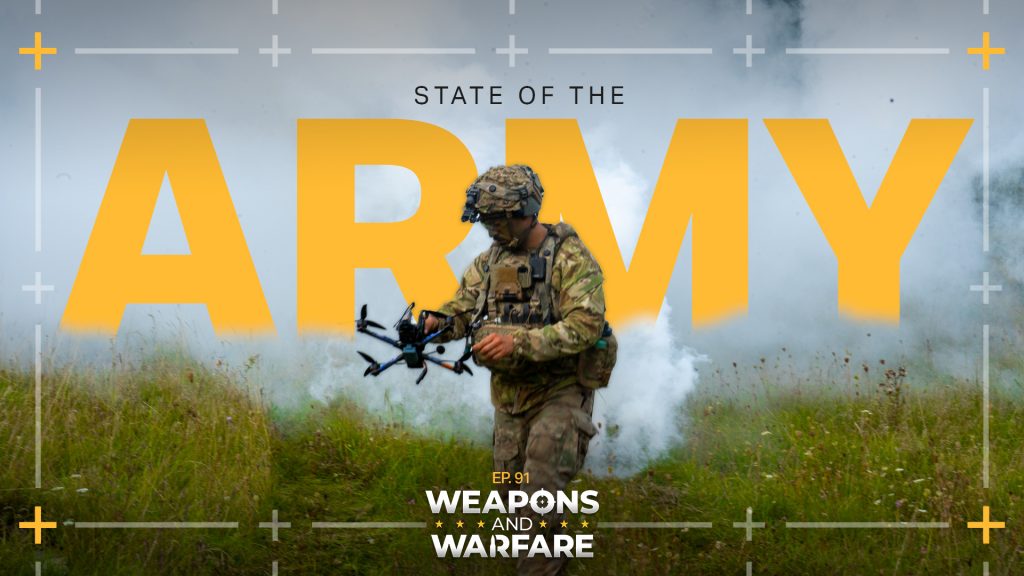AUSA 2025: ‘The Army is going to transform,’ and CROWS gets an upgrade

This week on Weapons and Warfare, host Ryan Robertson reports from the Association of the United States Army (AUSA) 2025 national event in Washington, D.C. Ryan offers an in-depth look at the current state of the U.S. Army, as we hear from top military leaders, including Secretary of the Army Dan Driscoll and Army Chief of Staff Gen. Randy George, who discuss key priorities, modernization efforts and the challenges facing the Army today.
During a ceremony marking the U.S. Army’s 250th anniversary, top military leaders emphasized the urgent need to modernize and adapt to meet future threats. George and Driscoll used the occasion to call for swift transformation across the branch.
“We talk a lot about when we built the Army, and a lot of the systems that we have, you could take five to seven years to build it, and you could take 15 or 20 years to field it to your formation,” George said. “We cannot do that anymore.”
Driscoll echoed the urgency, challenging attendees to reflect on their roles in preparing soldiers for combat, saying, “For our Army to meet this moment, every single person, especially those at this conference, must be able to answer yes to one very simple question: Am I focusing my energy and effort so that soldiers are ready to fight and win our nation’s wars?”
The leaders pointed to lessons learned from the war in Ukraine, where the rapid evolution of battlefield technology has reshaped military strategy. Driscoll said drones now define modern warfare, replacing the dominance of small arms seen in the 20th century.
“They are the perfect convergence of artificial intelligence, advanced materials, batteries and propulsion systems, sensor fusion and much more,” Driscoll said. “They are reshaping how humans inflict violence on each other at a pace never witnessed in human history.”
He cited the 101st Airborne Division’s efforts to manufacture drones at the EagleWerx Applied Tactical Innovation Center at Fort Campbell, Kentucky, as a model for innovation. George said such initiatives could guide the Army’s broader modernization efforts and help build partnerships with industry.
“I have been down on the floor, and I know there are things that we can help produce at scale that can help industry,” George said. “This is a hardened drone that has been flown successfully in Ukraine. So that is the other thing — making sure our drones are exactly what we need.”
Driscoll also criticized bureaucratic inefficiencies that he said empower adversaries and endanger soldiers. He called for immediate action to streamline operations and accelerate innovation.
“No one can predict the next war. But we cannot wait,” Driscoll said. “We must act now to enable our soldiers. Our window to change is right now, and we have a plan to do it. We will set the pace of innovation, and we will win with silicon and silicone and software, and not our soldiers’ blood and bodies.”
Both leaders concluded by warning that the greatest threat to progress is resistance to change. George said transformation is inevitable and necessary.
“The Army is going to transform. We are going to move out with this,” George said. “We want you to come with us, and we need you. Our soldiers are ready to change.”
Driscoll added that the Army’s future depends on its ability to evolve.
“The next 250 years are ours to forge, and we will,” he said. “We will continuously transform how we fight, how we build and how we care for our soldiers. We will break the barriers of bureaucracy, inefficiency and complacency. We will ensure that America’s Army remains the most lethal fighting force in the world, and it starts by placing our soldiers first.”
Weapon of the Week: CROWS tech refresh modernizes a battlefield staple
This week’s weapon of the week isn’t new — but it’s getting a major upgrade. Kongsberg’s Common Remotely Operated Weapon Station, or CROWS, is undergoing a technology refresh that could reshape how U.S. forces engage threats.
The CROWS system has served the U.S. military for more than two decades. Kongsberg has produced 17,000 units for American forces and 20,000 worldwide. The system allows troops to operate weapons remotely, keeping them protected while maintaining firepower.
“We worked with the government to identify obsolete parts,” said John McGee, business development director at Kongsberg. “That opened the door to digitization.”

The refresh replaces analog components with digital processors and upgraded sensors. These changes improve performance, reliability and connectivity across the battlefield.
“We’ve replaced thermals, sensors, and internal processors,” McGee said. “Most upgrades are inside the system and software-driven.”
The new CROWS units can now be networked, allowing systems to share targeting data and coordinate across platforms. This capability is especially valuable in counter-UAS operations.
“You can add radar, processing power, and connect systems through a communications backbone,” McGee said. “We’re agnostic to those components.”
Kongsberg’s collaborative fire control system enables CROWS to work with other platforms and effectors. This allows warfighters to share targets and respond faster.
“We can tie systems together and share targets,” McGee said. “That gives warfighters a lethal, flexible network.”
The tech refresh includes both new builds and conversions of legacy systems. Production is active at Kongsberg’s facility in Johnstown, Pennsylvania, which has supported the program for 20 years.
“Some units are brand new. Others are upgraded from older systems,” McGee said. “We’re building and converting in parallel.”
The ability to upgrade existing systems saves time and money while extending the life of proven platforms. It also allows the military to adapt quickly to emerging threats.
“You don’t need to start from scratch,” McGee said. “You can add capability to what’s already in the field.”
As drone threats grow and battlefield networks become more complex, Kongsberg’s refreshed CROWS system offers a scalable solution. It blends legacy reliability with modern connectivity — ready to meet today’s operational demands.
You can subscribe to the Weapons and Warfare podcast on the platform of your choosing here.
The post AUSA 2025: ‘The Army is going to transform,’ and CROWS gets an upgrade appeared first on Straight Arrow News.





